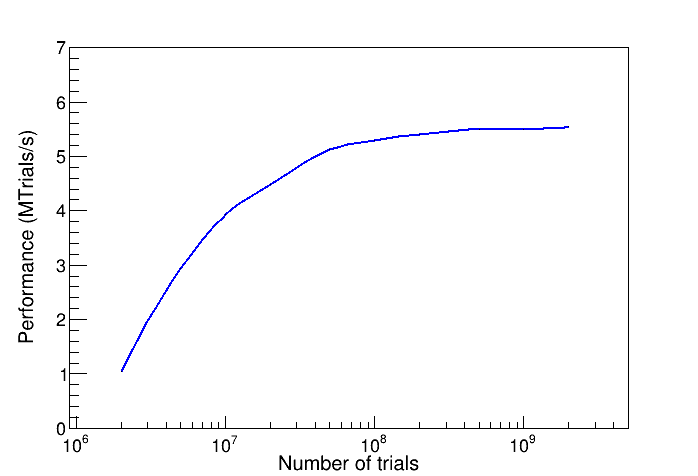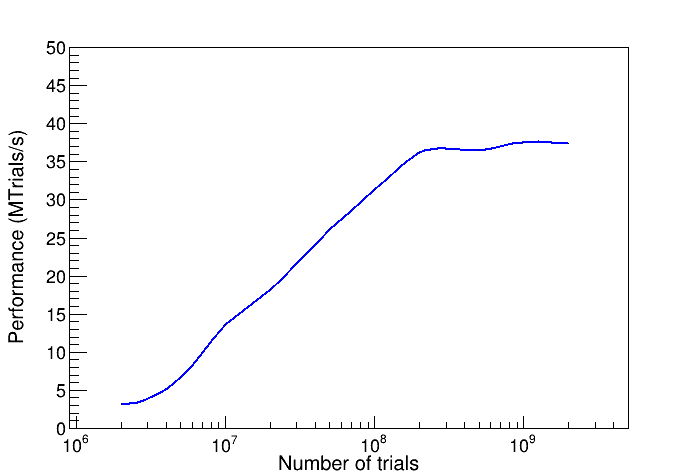Muon Stopping Power and Range
Each example consists of a main code to be linked with the Muon Range Library. The examples calculate the range or energy loss in materials, the material thickness that would cause a given energy decrement, or simply output a formatted stopping power and range table.
Example Codes
After package installation, the example codes can be found in /usr/share/doc/murange/examples/.
Table of Contents
- Example 1: Calculate the range of a 200 MeV/c muon and 1 GeV kinetic energy in Iron
- Example 2: Print a stopping power and range table for Stainless Steel 316L
- Example 3: Calculate the energy loss of a 30 GeV muon in 5 g/cm² Deuterium gas at 5 atm
- Example 4: Calculate the energy loss of a 10 MeV muon in 1 g/cm² Cobalt-Chromium allow (ASTM-F75)
- Example 5: Calculate the thickness of concrete needed to reduce the muon energy from 300 MeV to 200 MeV
- Example 6: Calculate energy range of a 30 GeV muon in Carbon Tetrafluoride at 1 atm and 100 Torr
- Example 7: Calculate energy loss iteratively to estimate the computing performance
Example 1
The following example code creates an element, a range table for the element, a muon object, and outputs the range at muon momentum 200 MeV/c and 1 GeV kinetic energy,
#include <iostream>
#include <murange.hpp>
int main() {
// Iron (Fe)
Material *Fe = new Element("Fe");
// range table for element Fe
Range *rFe = new Range(Fe);
// muon with momentum 200 MeV/c
Muon *mu = new Muon();
mu->SetMomentum(200);
// method 1
cout << rFe->GetRange(mu) << " MeV/cm2" << endl;
// method 2
cout << rFe->GetRange(1000) << " MeV/cm2" << endl;
delete mu;
delete rFe;
delete Fe;
return EXIT_SUCCESS;
}
The outcome of this example is,
$ ./GetRange-example
56.7843 MeV/cm2
640.323 MeV/cm2
Example 2
The following example code creates a material (Stainless Steel 316L) and prints to standard output a stopping power and range table,
#include <iostream>
#include <murange.hpp>
int main() {
// Stainless Steel 316L
Material *mat = new Mixture(502);
Range *rng = new Range(mat);
// print stopping power and range table
rng->PrintRangeTable();
delete rng;
delete mat;
return EXIT_SUCCESS;
}
The outcome of this example is,
$ ./PrintRangeTable-example
̶̶̶̶̶̶̶̶̶̶̶̶̶̶̶̶̶̶̶̶̶̶̶̶̶̶̶̶̶̶̶̶̶̶̶̶̶̶̶̶̶̶̶̶̶̶̶̶̶̶̶̶̶̶̶̶̶̶̶̶̶̶̶̶̶̶̶̶̶̶̶̶̶̶̶̶̶̶̶̶̶̶̶̶̶̶̶̶̶̶̶̶̶̶̶̶̶
Stainless Steel (316L) (502)
<Z/A> ρ[g/cm³] I[ev] a k=ms x₀ x₁ C δ₀
0.46537 7.990000 323.4 0.16410 3.00000 0.2000 3.0000 4.5224 0.00
̶̶̶̶̶̶̶̶̶̶̶̶̶̶̶̶̶̶̶̶̶̶̶̶̶̶̶̶̶̶̶̶̶̶̶̶̶̶̶̶̶̶̶̶̶̶̶̶̶̶̶̶̶̶̶̶̶̶̶̶̶̶̶̶̶̶̶̶̶̶̶̶̶̶̶̶̶̶̶̶̶̶̶̶̶̶̶̶̶̶̶̶̶̶̶̶̶
T p Ioization Brems Pair prod Photonucl Total CSDA Range
[MeV] [MeV/c] [MeV cm²/g] [MeV cm²/g] [MeV cm²/g] [MeV cm²/g] [MeV cm²/g] [g/cm²]
̶̶̶̶̶̶̶̶̶̶̶̶̶̶̶̶̶̶̶̶̶̶̶̶̶̶̶̶̶̶̶̶̶̶̶̶̶̶̶̶̶̶̶̶̶̶̶̶̶̶̶̶̶̶̶̶̶̶̶̶̶̶̶̶̶̶̶̶̶̶̶̶̶̶̶̶̶̶̶̶̶̶̶̶̶̶̶̶̶̶̶̶̶̶̶̶̶
10.0 4.704E+01 5.415 0.000 0.000 0.000 5.415 1.054E+00
14.0 5.616E+01 4.261 0.000 0.000 0.000 4.261 1.895E+00
20.0 6.802E+01 3.355 0.000 0.000 0.000 3.355 3.500E+00
30.0 8.509E+01 2.625 0.000 0.000 0.000 2.625 6.915E+00
40.0 1.003E+02 2.254 0.000 0.000 0.000 2.254 1.105E+01
80.0 1.527E+02 1.714 0.000 0.000 0.000 1.714 3.203E+01
100.0 1.764E+02 1.617 0.000 0.000 0.000 1.617 4.407E+01
140.0 2.218E+02 1.519 0.000 0.000 0.000 1.519 6.971E+01
200.0 2.868E+02 1.467 0.000 0.000 0.000 1.467 1.100E+02
300.0 3.917E+02 1.457 0.000 0.000 0.000 1.457 1.786E+02
400.0 4.945E+02 1.473 0.000 0.000 0.000 1.473 2.469E+02
800.0 8.995E+02 1.554 0.000 0.000 0.000 1.554 5.112E+02
1000.0 1.101E+03 1.587 0.001 0.000 0.000 1.588 6.384E+02
1400.0 1.502E+03 1.641 0.001 0.000 0.001 1.643 8.858E+02
2000.0 2.103E+03 1.700 0.002 0.001 0.001 1.703 1.244E+03
3000.0 3.104E+03 1.765 0.003 0.002 0.001 1.771 1.819E+03
4000.0 4.104E+03 1.811 0.004 0.004 0.002 1.820 2.375E+03
8000.0 8.105E+03 1.914 0.010 0.011 0.003 1.938 4.498E+03
10000.0 1.011E+04 1.944 0.014 0.015 0.004 1.977 5.520E+03
14000.0 1.411E+04 1.989 0.021 0.024 0.006 2.040 7.510E+03
20000.0 2.011E+04 2.033 0.033 0.039 0.008 2.113 1.040E+04
30000.0 3.011E+04 2.080 0.054 0.067 0.012 2.214 1.502E+04
40000.0 4.011E+04 2.112 0.077 0.098 0.016 2.302 1.945E+04
80000.0 8.011E+04 2.183 0.172 0.235 0.031 2.621 3.573E+04
100000.0 1.001E+05 2.205 0.223 0.309 0.038 2.775 4.314E+04
140000.0 1.401E+05 2.237 0.328 0.462 0.054 3.081 5.683E+04
200000.0 2.001E+05 2.271 0.492 0.704 0.076 3.543 7.498E+04
300000.0 3.001E+05 2.310 0.772 1.110 0.114 4.306 1.006E+05
400000.0 4.001E+05 2.337 1.062 1.530 0.152 5.081 1.220E+05
800000.0 8.001E+05 2.404 2.263 3.259 0.307 8.232 1.837E+05
1000000.0 1.000E+06 2.426 2.880 4.144 0.386 9.835 2.059E+05
1400000.0 1.400E+06 2.459 4.119 5.912 0.547 13.036 2.412E+05
2000000.0 2.000E+06 2.494 6.017 8.612 0.791 17.913 2.803E+05
3000000.0 3.000E+06 2.535 9.188 13.102 1.210 26.034 3.265E+05
4000000.0 4.000E+06 2.564 12.404 17.641 1.636 34.245 3.599E+05
8000000.0 8.000E+06 2.636 25.386 35.893 3.404 67.319 4.421E+05
10000000.0 1.000E+07 2.660 31.934 45.072 4.313 83.979 4.687E+05
14000000.0 1.400E+07 2.696 44.995 63.382 6.180 117.253 5.088E+05
20000000.0 2.000E+07 2.735 64.715 90.976 9.045 167.471 5.514E+05
30000000.0 3.000E+07 2.780 97.544 136.895 14.000 251.220 5.999E+05
40000000.0 4.000E+07 2.813 130.505 182.930 19.077 335.325 6.342E+05
80000000.0 8.000E+07 2.893 262.586 367.168 40.303 672.950 7.167E+05
100000000.0 1.000E+08 2.920 328.757 459.361 51.277 842.314 7.432E+05
̶̶̶̶̶̶̶̶̶̶̶̶̶̶̶̶̶̶̶̶̶̶̶̶̶̶̶̶̶̶̶̶̶̶̶̶̶̶̶̶̶̶̶̶̶̶̶̶̶̶̶̶̶̶̶̶̶̶̶̶̶̶̶̶̶̶̶̶̶̶̶̶̶̶̶̶̶̶̶̶̶̶̶̶̶̶̶̶̶̶̶̶̶̶̶̶̶
Example 3
The following example code creates an element (Deuterium, gaseous), a range table for the element, a muon object with 30 GeV kinetic energy, and outputs the energy loss and outgoing energy after passage through 5 g/cm² D gas at 5 atm,
#include <iostream>
#include <murange.hpp>
int main() {
// Deuterium (D)
Material *D = new Element("D");
// set density to 5 atm
D->SetDensity(5,"atm");
// range table for gaseous D
Range *rD = new Range(D);
// muon with kinetic energy 30 GeV
Muon *mu = new Muon(30000);
// method 1
D->SetThickness(5);
cout << rD->GetOutgoingEnergy(mu) << " MeV energy loss" << endl;
cout << mu->GetKEnergy() << " MeV" << endl;
cout << endl;
// method 2
mu->SetKEnergy(30000);
cout << rD->GetOutgoingEnergy(mu,5) << " MeV energy loss" << endl;
cout << mu->GetKEnergy() << " MeV" << endl;
cout << endl;
// method 3
cout << rD->GetOutgoingEnergy(30000,5) << " MeV energy loss" << endl;
delete mu;
delete rD;
delete D;
return EXIT_SUCCESS;
}
The outcome of this example is,
$ ./GetOutgoingEnergy-example
14.9812 MeV energy loss
29985 MeV
14.9812 MeV energy loss
29985 MeV
14.9812 MeV energy loss
Example 4
The following example code creates a mixture (Co-Cr ASTM-F75), a range table for the mixture, a muon object with 10 MeV kinetic energy, and outputs the energy loss and ingoing energy before passage through 1 g/cm² liquid Deuterium,
#include <iostream>
#include <murange.hpp>
int main() {
// muon with kinetic energy 10 MeV
Muon *mu = new Muon(10);
// Cobalt-Chromium (ASTM-F75)
Material *CoCr = new Mixture(532);
// range table for Cobalt-Chromium
Range *rCoCr = new Range(CoCr);
// method 1
CoCr->SetThickness(1);
cout << rCoCr->GetIngoingEnergy(mu) << " MeV energy loss" << endl;
cout << mu->GetKEnergy() << " MeV" << endl;
cout << endl;
// method 2
mu->SetKEnergy(10);
cout << rCoCr->GetIngoingEnergy(mu,1) << " MeV energy loss" << endl;
cout << mu->GetKEnergy() << " MeV" << endl;
cout << endl;
// method 3
cout << rCoCr->GetIngoingEnergy(10,1) << " MeV energy loss" << endl;
delete rCoCr;
delete CoCr;
delete mu;
return EXIT_SUCCESS;
}
The outcome of this example is,
$ ./GetIngoingEnergy-example
4.59922 MeV energy loss
14.5992 MeV
4.59922 MeV energy loss
14.5992 MeV
4.59922 MeV energy loss
Example 5
The following example code creates an mixture (Concrete), a range table for the mixture, a muon object with 300 MeV kinetic energy, and outputs the material thickness needed to reduce the kinetic energy to 200 MeV.
#include <iostream>
#include <murange.hpp>
int main() {
// Concrete (Ordinary)
Material *mat = new Mixture(518);
// range table for concrete
Range *r = new Range(mat);
// muon with kinetic energy 300 MeV
Muon *mu = new Muon(300.);
// method 1
double s = r->GetMaterialThickness(mu,-100.);
cout << "material thickness " << s << " g/cm2, or " << s/mat->GetDensity() << " cm concrete" << endl;
cout << "initial KE " << mu->GetKEnergy() << " MeV, energy loss " << r->GetOutgoingEnergy(mu,s) <<
" MeV, final KE " << mu->GetKEnergy() << " MeV" << endl;
// method 2
s = r->GetMaterialThickness(300.,-100.);
cout << "material thickness " << s << " g/cm2, or " << s/mat->GetDensity() << " cm concrete" << endl;
delete mu;
delete r;
delete mat;
return EXIT_SUCCESS;
}
The outcome of this example is,
$ ./GetMaterialThickness-example
material thickness 57.4584 g/cm2, or 24.9819 cm concrete
initial KE 300 MeV, energy loss 100 MeV, final KE 200 MeV
material thickness 57.4584 g/cm2, or 24.9819 cm concrete
Example 6
The following example code calculates the range of a 30 GeV muon in Carbon Tetrafluoride (CF4) at 1 atm and 100 Torr,
#include <iostream>
#include <murange.hpp>
int main() {
// muon with kinetic energy 30 GeV
Muon *mu = new Muon(30e3);
// range table for CF4
Material *CF4 = new Compound(326);
Range *rCF4 = new Range(CF4);
cout << "Range of" << mu->GetKEnergy()/1000 << " GeV muon in CF4 at 1 atm: " <<
rCF4->GetRange(mu) << " MeV/cm2" << endl;
// change the density to 100 Torr
CF4->SetDensity(100,"Torr");
// new range table for CF4
delete rCF4;
rCF4 = new Range(CF4);
cout << "Range of" << mu->GetKEnergy()/1000 << " GeV muon in CF4 at 100 Torr: " <<
rCF4->GetRange(mu) << " MeV/cm2" << endl;
delete rCF4;
delete CF4;
delete mu;
return EXIT_SUCCESS;
}
The outcome of this example is,
$ ./cf4-range
Range of 30 GeV muon in CF4 at 1 atm: 12171.4 MeV/cm2
Range of 30 GeV muon in CF4 at 1 Torr: 11934.8 MeV/cm2
This demonstrates the density dependence of the electronic stopping power.
Example 7
The following example code creates an element (Si), a range table and sets the muon kinetic energy randomly, from 10 to 100 MeV, then calculates
the energy loss in 1-10 g/cm² Si, iterated over tries times. The OpenMP time function is used to estimate the performance [Mtrials/s],
#include <iostream>
#include <ctime>
#include <murange.hpp>
#include <omp.h>
int main(int argc, char **argv) {
// number of tries
unsigned long tries = atol(argv[1]);
srand(time(NULL));
// start time
double start_time = omp_get_wtime();
// Si range table
Material *Si = new Element("Si");
Range *rSi = new Range(Si);
for ( int i = 0 ; i < tries ; i++ ) {
// kinetic energy between 10 and 100 MeV
double ke = (rand()%(90000000)+10000000)/1000000.;
// thickness between 1 and 10 g/cm2
double s = (rand()%(90000000)+10000000)/10000000.;
rSi->GetOutgoingEnergy(ke,s);
}
// stop time
double stop_time = omp_get_wtime();
double performance = (double)tries / (time_stop-time_start) / 1000000.;
fprintf(stderr,"\nnumber of tries: %ld\n",tries);
fprintf(stderr,"execution time: %g s\n",time_stop-time_start);
fprintf(stderr,"performance: %g Mtrials/s\n\n",performance);
delete rSi;
delete Si;
return EXIT_SUCCESS;;
}
The outcome of this example is,
$ ./performance 100000000
number of tries: 100000000
execution time: 18.8887 s
performance: 5.29418 Mtrials/s
The plot shows the performance as a function of number of trials, a useful measure when performing Monte Carlo simulations.

A similar OpenMP version of the above code, with 8 threads, gives,
$ ./performance-omp 8 100000000
using OpenMP with 8/16 threads
number of tries: 100000000
execution time: 3.22482 s
performance: 31.0095 Mtrials/s
and performance plot,
